Strategic HRM management Assignment 2022
VerifiedAdded on 2022/10/17
|8
|2243
|11
Assignment
AI Summary
Contribute Materials
Your contribution can guide someone’s learning journey. Share your
documents today.
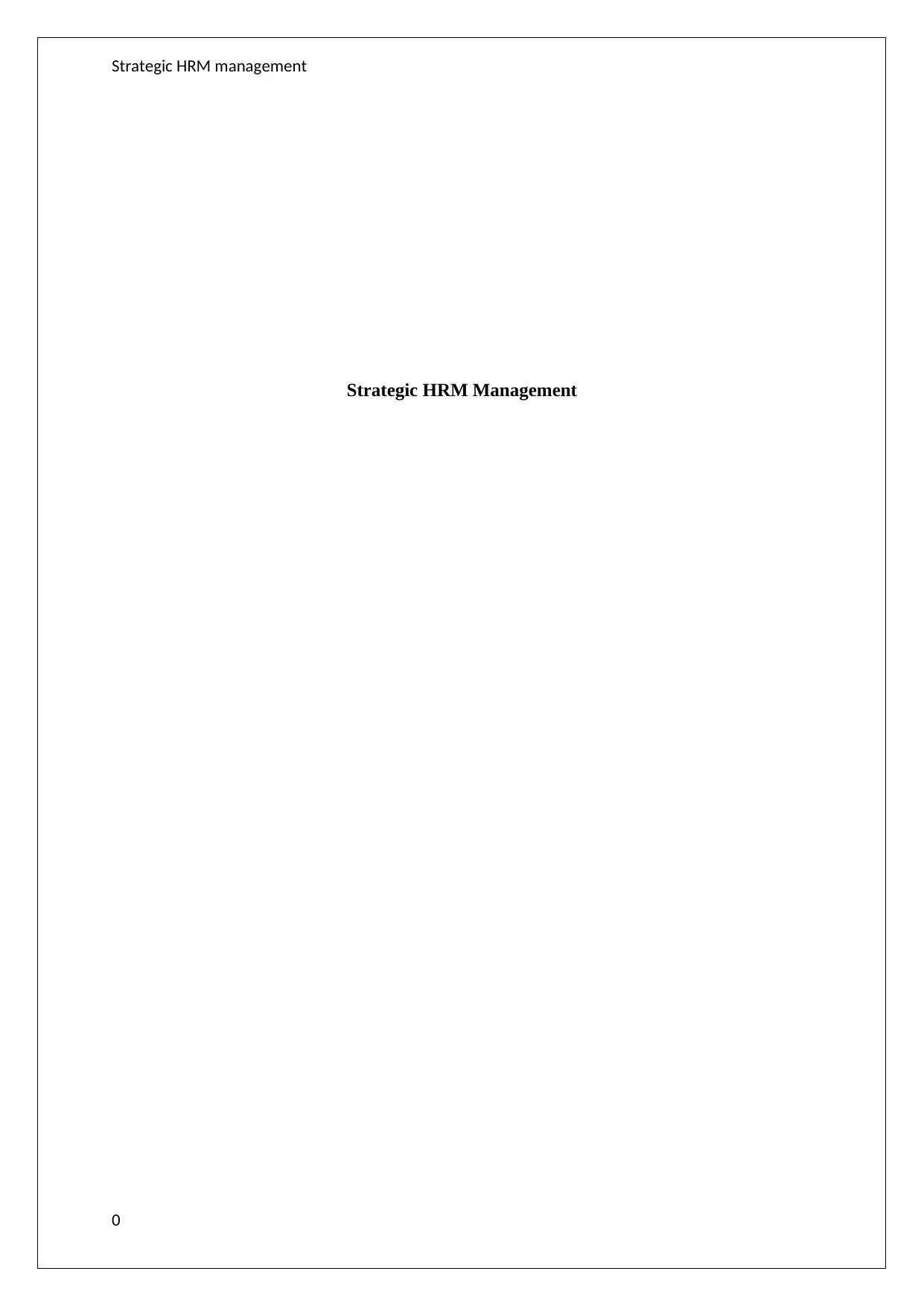
Strategic HRM management
Strategic HRM Management
0
Strategic HRM Management
0
Secure Best Marks with AI Grader
Need help grading? Try our AI Grader for instant feedback on your assignments.
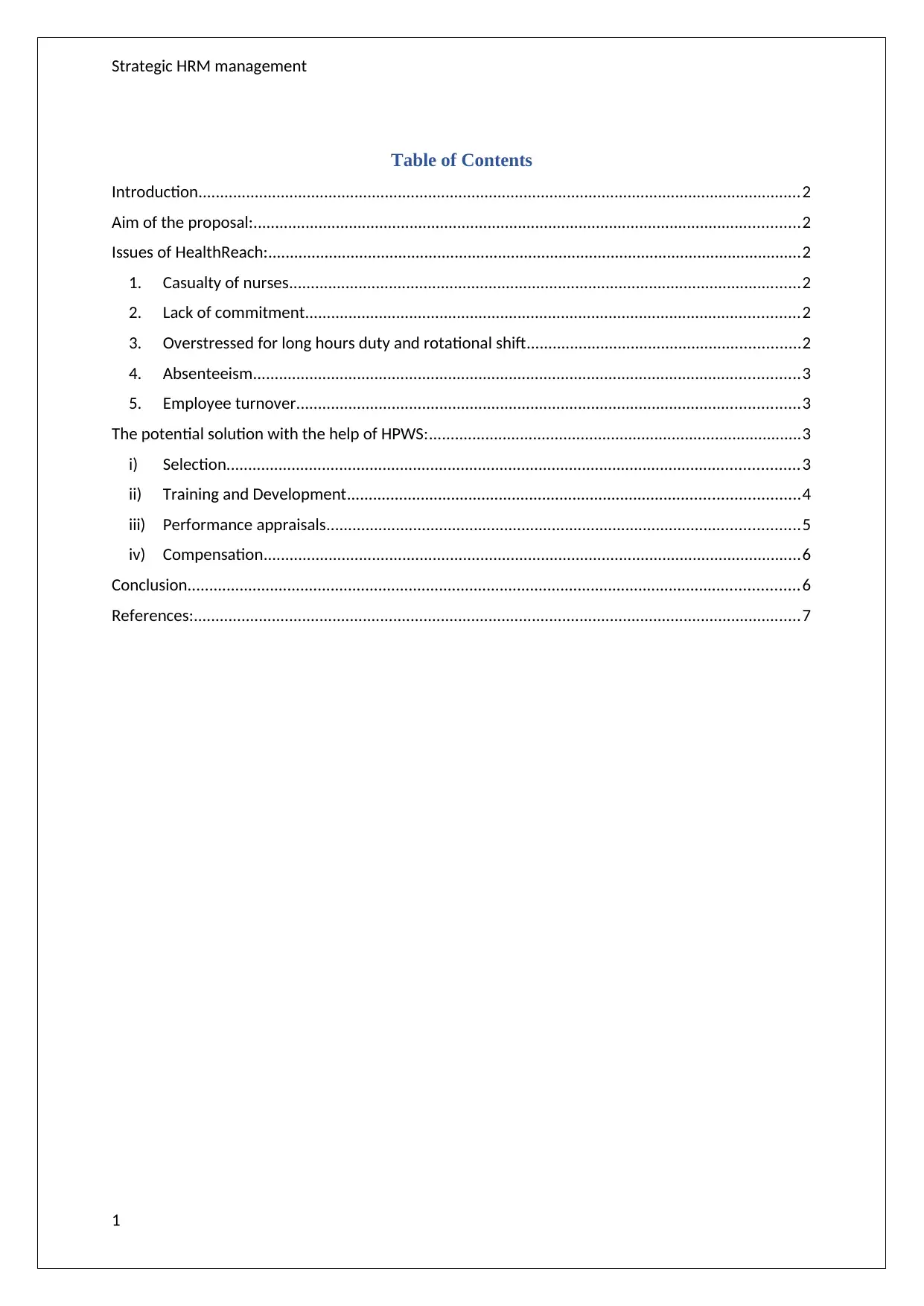
Strategic HRM management
Table of Contents
Introduction...........................................................................................................................................2
Aim of the proposal:..............................................................................................................................2
Issues of HealthReach:...........................................................................................................................2
1. Casualty of nurses......................................................................................................................2
2. Lack of commitment..................................................................................................................2
3. Overstressed for long hours duty and rotational shift...............................................................2
4. Absenteeism..............................................................................................................................3
5. Employee turnover....................................................................................................................3
The potential solution with the help of HPWS:......................................................................................3
i) Selection....................................................................................................................................3
ii) Training and Development........................................................................................................4
iii) Performance appraisals.............................................................................................................5
iv) Compensation............................................................................................................................6
Conclusion.............................................................................................................................................6
References:............................................................................................................................................7
1
Table of Contents
Introduction...........................................................................................................................................2
Aim of the proposal:..............................................................................................................................2
Issues of HealthReach:...........................................................................................................................2
1. Casualty of nurses......................................................................................................................2
2. Lack of commitment..................................................................................................................2
3. Overstressed for long hours duty and rotational shift...............................................................2
4. Absenteeism..............................................................................................................................3
5. Employee turnover....................................................................................................................3
The potential solution with the help of HPWS:......................................................................................3
i) Selection....................................................................................................................................3
ii) Training and Development........................................................................................................4
iii) Performance appraisals.............................................................................................................5
iv) Compensation............................................................................................................................6
Conclusion.............................................................................................................................................6
References:............................................................................................................................................7
1
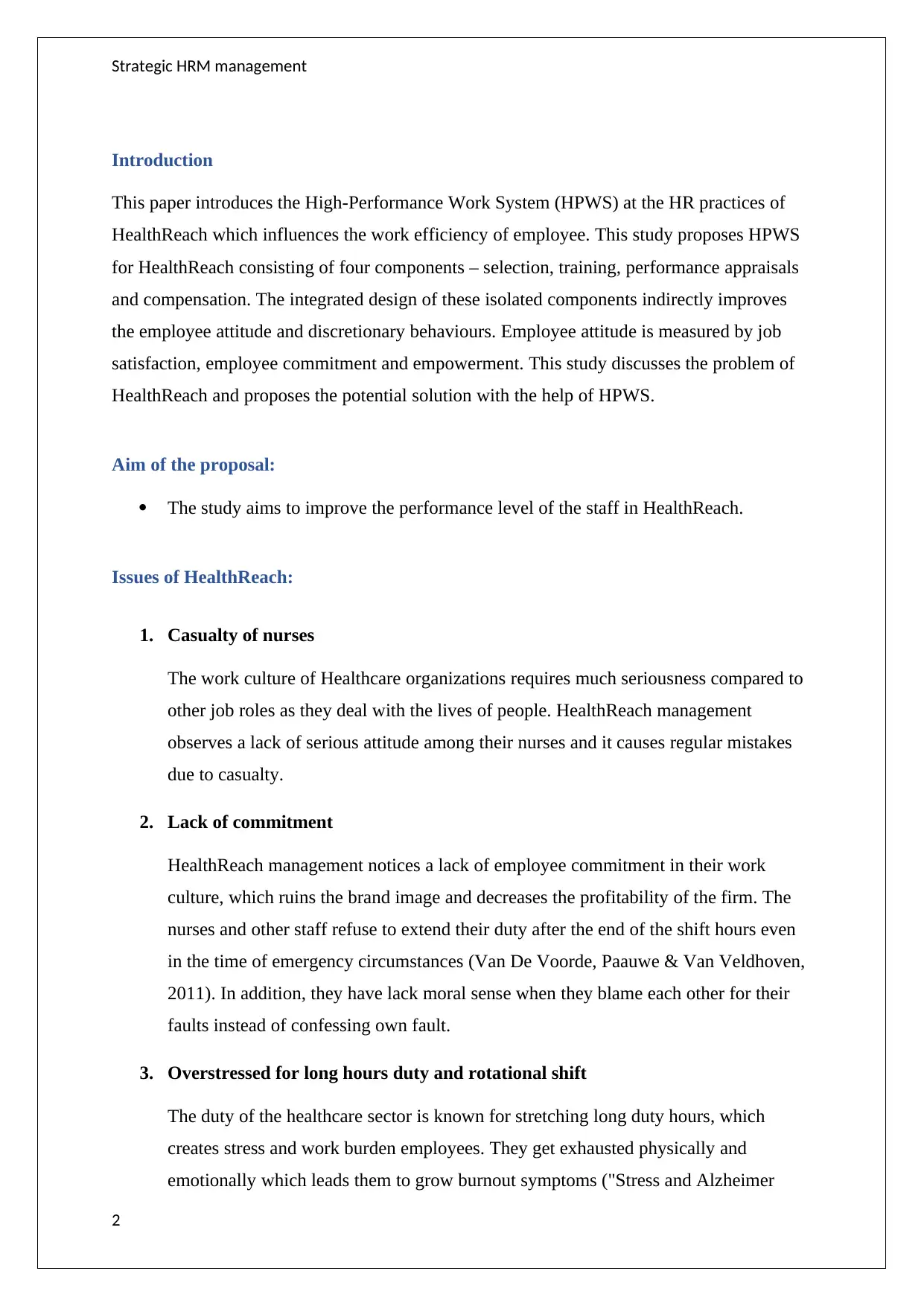
Strategic HRM management
Introduction
This paper introduces the High-Performance Work System (HPWS) at the HR practices of
HealthReach which influences the work efficiency of employee. This study proposes HPWS
for HealthReach consisting of four components – selection, training, performance appraisals
and compensation. The integrated design of these isolated components indirectly improves
the employee attitude and discretionary behaviours. Employee attitude is measured by job
satisfaction, employee commitment and empowerment. This study discusses the problem of
HealthReach and proposes the potential solution with the help of HPWS.
Aim of the proposal:
The study aims to improve the performance level of the staff in HealthReach.
Issues of HealthReach:
1. Casualty of nurses
The work culture of Healthcare organizations requires much seriousness compared to
other job roles as they deal with the lives of people. HealthReach management
observes a lack of serious attitude among their nurses and it causes regular mistakes
due to casualty.
2. Lack of commitment
HealthReach management notices a lack of employee commitment in their work
culture, which ruins the brand image and decreases the profitability of the firm. The
nurses and other staff refuse to extend their duty after the end of the shift hours even
in the time of emergency circumstances (Van De Voorde, Paauwe & Van Veldhoven,
2011). In addition, they have lack moral sense when they blame each other for their
faults instead of confessing own fault.
3. Overstressed for long hours duty and rotational shift
The duty of the healthcare sector is known for stretching long duty hours, which
creates stress and work burden employees. They get exhausted physically and
emotionally which leads them to grow burnout symptoms ("Stress and Alzheimer
2
Introduction
This paper introduces the High-Performance Work System (HPWS) at the HR practices of
HealthReach which influences the work efficiency of employee. This study proposes HPWS
for HealthReach consisting of four components – selection, training, performance appraisals
and compensation. The integrated design of these isolated components indirectly improves
the employee attitude and discretionary behaviours. Employee attitude is measured by job
satisfaction, employee commitment and empowerment. This study discusses the problem of
HealthReach and proposes the potential solution with the help of HPWS.
Aim of the proposal:
The study aims to improve the performance level of the staff in HealthReach.
Issues of HealthReach:
1. Casualty of nurses
The work culture of Healthcare organizations requires much seriousness compared to
other job roles as they deal with the lives of people. HealthReach management
observes a lack of serious attitude among their nurses and it causes regular mistakes
due to casualty.
2. Lack of commitment
HealthReach management notices a lack of employee commitment in their work
culture, which ruins the brand image and decreases the profitability of the firm. The
nurses and other staff refuse to extend their duty after the end of the shift hours even
in the time of emergency circumstances (Van De Voorde, Paauwe & Van Veldhoven,
2011). In addition, they have lack moral sense when they blame each other for their
faults instead of confessing own fault.
3. Overstressed for long hours duty and rotational shift
The duty of the healthcare sector is known for stretching long duty hours, which
creates stress and work burden employees. They get exhausted physically and
emotionally which leads them to grow burnout symptoms ("Stress and Alzheimer
2
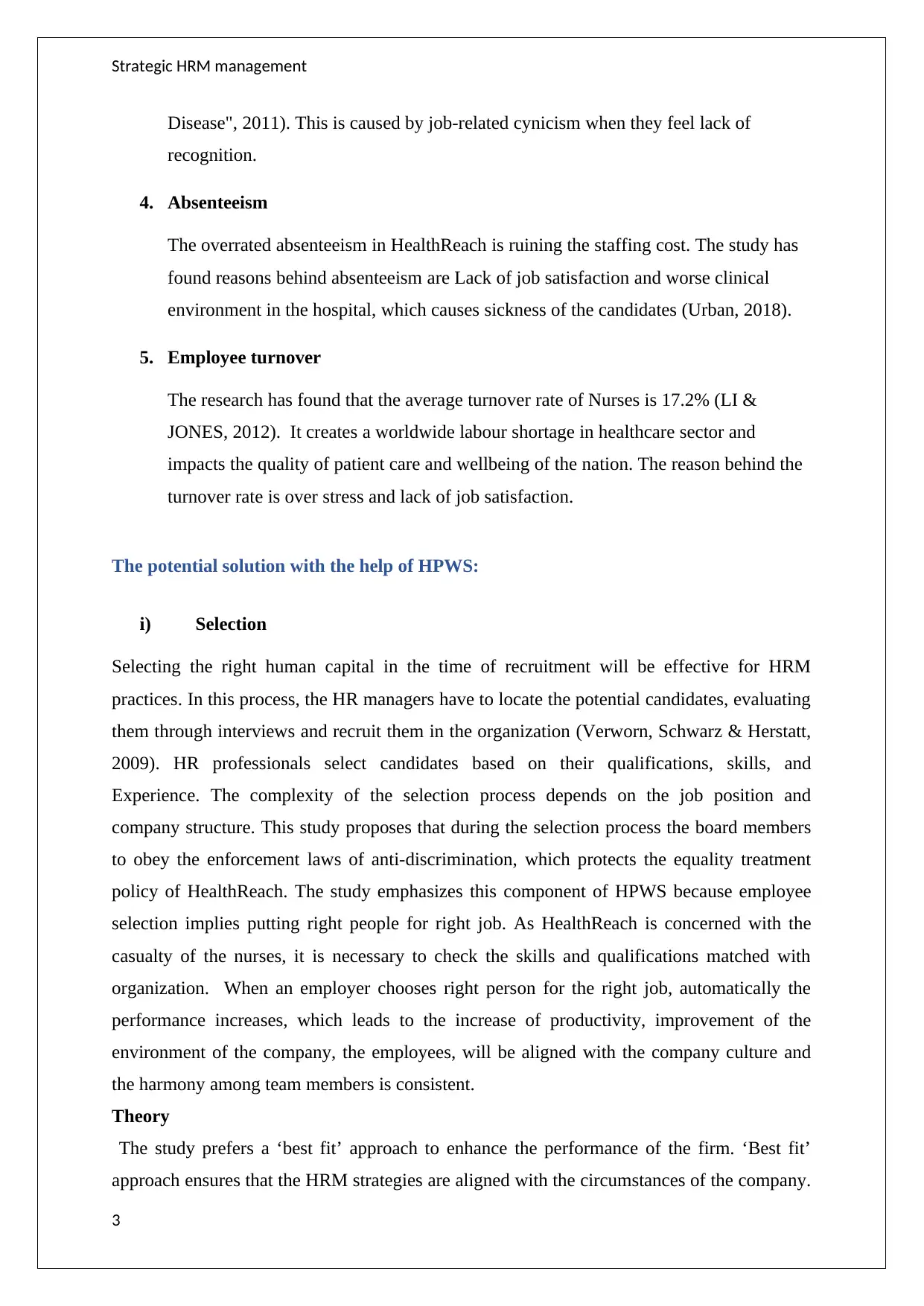
Strategic HRM management
Disease", 2011). This is caused by job-related cynicism when they feel lack of
recognition.
4. Absenteeism
The overrated absenteeism in HealthReach is ruining the staffing cost. The study has
found reasons behind absenteeism are Lack of job satisfaction and worse clinical
environment in the hospital, which causes sickness of the candidates (Urban, 2018).
5. Employee turnover
The research has found that the average turnover rate of Nurses is 17.2% (LI &
JONES, 2012). It creates a worldwide labour shortage in healthcare sector and
impacts the quality of patient care and wellbeing of the nation. The reason behind the
turnover rate is over stress and lack of job satisfaction.
The potential solution with the help of HPWS:
i) Selection
Selecting the right human capital in the time of recruitment will be effective for HRM
practices. In this process, the HR managers have to locate the potential candidates, evaluating
them through interviews and recruit them in the organization (Verworn, Schwarz & Herstatt,
2009). HR professionals select candidates based on their qualifications, skills, and
Experience. The complexity of the selection process depends on the job position and
company structure. This study proposes that during the selection process the board members
to obey the enforcement laws of anti-discrimination, which protects the equality treatment
policy of HealthReach. The study emphasizes this component of HPWS because employee
selection implies putting right people for right job. As HealthReach is concerned with the
casualty of the nurses, it is necessary to check the skills and qualifications matched with
organization. When an employer chooses right person for the right job, automatically the
performance increases, which leads to the increase of productivity, improvement of the
environment of the company, the employees, will be aligned with the company culture and
the harmony among team members is consistent.
Theory
The study prefers a ‘best fit’ approach to enhance the performance of the firm. ‘Best fit’
approach ensures that the HRM strategies are aligned with the circumstances of the company.
3
Disease", 2011). This is caused by job-related cynicism when they feel lack of
recognition.
4. Absenteeism
The overrated absenteeism in HealthReach is ruining the staffing cost. The study has
found reasons behind absenteeism are Lack of job satisfaction and worse clinical
environment in the hospital, which causes sickness of the candidates (Urban, 2018).
5. Employee turnover
The research has found that the average turnover rate of Nurses is 17.2% (LI &
JONES, 2012). It creates a worldwide labour shortage in healthcare sector and
impacts the quality of patient care and wellbeing of the nation. The reason behind the
turnover rate is over stress and lack of job satisfaction.
The potential solution with the help of HPWS:
i) Selection
Selecting the right human capital in the time of recruitment will be effective for HRM
practices. In this process, the HR managers have to locate the potential candidates, evaluating
them through interviews and recruit them in the organization (Verworn, Schwarz & Herstatt,
2009). HR professionals select candidates based on their qualifications, skills, and
Experience. The complexity of the selection process depends on the job position and
company structure. This study proposes that during the selection process the board members
to obey the enforcement laws of anti-discrimination, which protects the equality treatment
policy of HealthReach. The study emphasizes this component of HPWS because employee
selection implies putting right people for right job. As HealthReach is concerned with the
casualty of the nurses, it is necessary to check the skills and qualifications matched with
organization. When an employer chooses right person for the right job, automatically the
performance increases, which leads to the increase of productivity, improvement of the
environment of the company, the employees, will be aligned with the company culture and
the harmony among team members is consistent.
Theory
The study prefers a ‘best fit’ approach to enhance the performance of the firm. ‘Best fit’
approach ensures that the HRM strategies are aligned with the circumstances of the company.
3
Secure Best Marks with AI Grader
Need help grading? Try our AI Grader for instant feedback on your assignments.
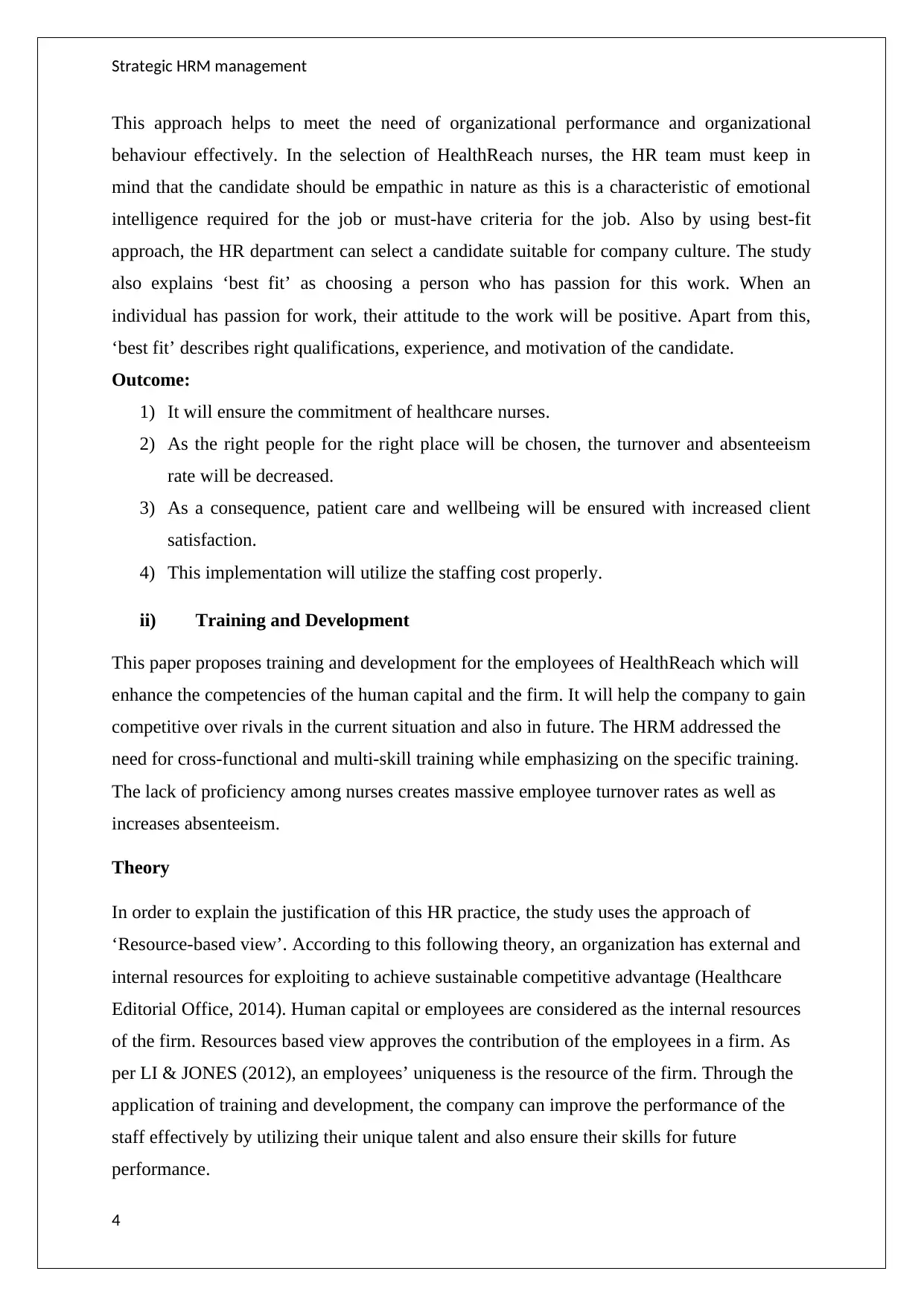
Strategic HRM management
This approach helps to meet the need of organizational performance and organizational
behaviour effectively. In the selection of HealthReach nurses, the HR team must keep in
mind that the candidate should be empathic in nature as this is a characteristic of emotional
intelligence required for the job or must-have criteria for the job. Also by using best-fit
approach, the HR department can select a candidate suitable for company culture. The study
also explains ‘best fit’ as choosing a person who has passion for this work. When an
individual has passion for work, their attitude to the work will be positive. Apart from this,
‘best fit’ describes right qualifications, experience, and motivation of the candidate.
Outcome:
1) It will ensure the commitment of healthcare nurses.
2) As the right people for the right place will be chosen, the turnover and absenteeism
rate will be decreased.
3) As a consequence, patient care and wellbeing will be ensured with increased client
satisfaction.
4) This implementation will utilize the staffing cost properly.
ii) Training and Development
This paper proposes training and development for the employees of HealthReach which will
enhance the competencies of the human capital and the firm. It will help the company to gain
competitive over rivals in the current situation and also in future. The HRM addressed the
need for cross-functional and multi-skill training while emphasizing on the specific training.
The lack of proficiency among nurses creates massive employee turnover rates as well as
increases absenteeism.
Theory
In order to explain the justification of this HR practice, the study uses the approach of
‘Resource-based view’. According to this following theory, an organization has external and
internal resources for exploiting to achieve sustainable competitive advantage (Healthcare
Editorial Office, 2014). Human capital or employees are considered as the internal resources
of the firm. Resources based view approves the contribution of the employees in a firm. As
per LI & JONES (2012), an employees’ uniqueness is the resource of the firm. Through the
application of training and development, the company can improve the performance of the
staff effectively by utilizing their unique talent and also ensure their skills for future
performance.
4
This approach helps to meet the need of organizational performance and organizational
behaviour effectively. In the selection of HealthReach nurses, the HR team must keep in
mind that the candidate should be empathic in nature as this is a characteristic of emotional
intelligence required for the job or must-have criteria for the job. Also by using best-fit
approach, the HR department can select a candidate suitable for company culture. The study
also explains ‘best fit’ as choosing a person who has passion for this work. When an
individual has passion for work, their attitude to the work will be positive. Apart from this,
‘best fit’ describes right qualifications, experience, and motivation of the candidate.
Outcome:
1) It will ensure the commitment of healthcare nurses.
2) As the right people for the right place will be chosen, the turnover and absenteeism
rate will be decreased.
3) As a consequence, patient care and wellbeing will be ensured with increased client
satisfaction.
4) This implementation will utilize the staffing cost properly.
ii) Training and Development
This paper proposes training and development for the employees of HealthReach which will
enhance the competencies of the human capital and the firm. It will help the company to gain
competitive over rivals in the current situation and also in future. The HRM addressed the
need for cross-functional and multi-skill training while emphasizing on the specific training.
The lack of proficiency among nurses creates massive employee turnover rates as well as
increases absenteeism.
Theory
In order to explain the justification of this HR practice, the study uses the approach of
‘Resource-based view’. According to this following theory, an organization has external and
internal resources for exploiting to achieve sustainable competitive advantage (Healthcare
Editorial Office, 2014). Human capital or employees are considered as the internal resources
of the firm. Resources based view approves the contribution of the employees in a firm. As
per LI & JONES (2012), an employees’ uniqueness is the resource of the firm. Through the
application of training and development, the company can improve the performance of the
staff effectively by utilizing their unique talent and also ensure their skills for future
performance.
4
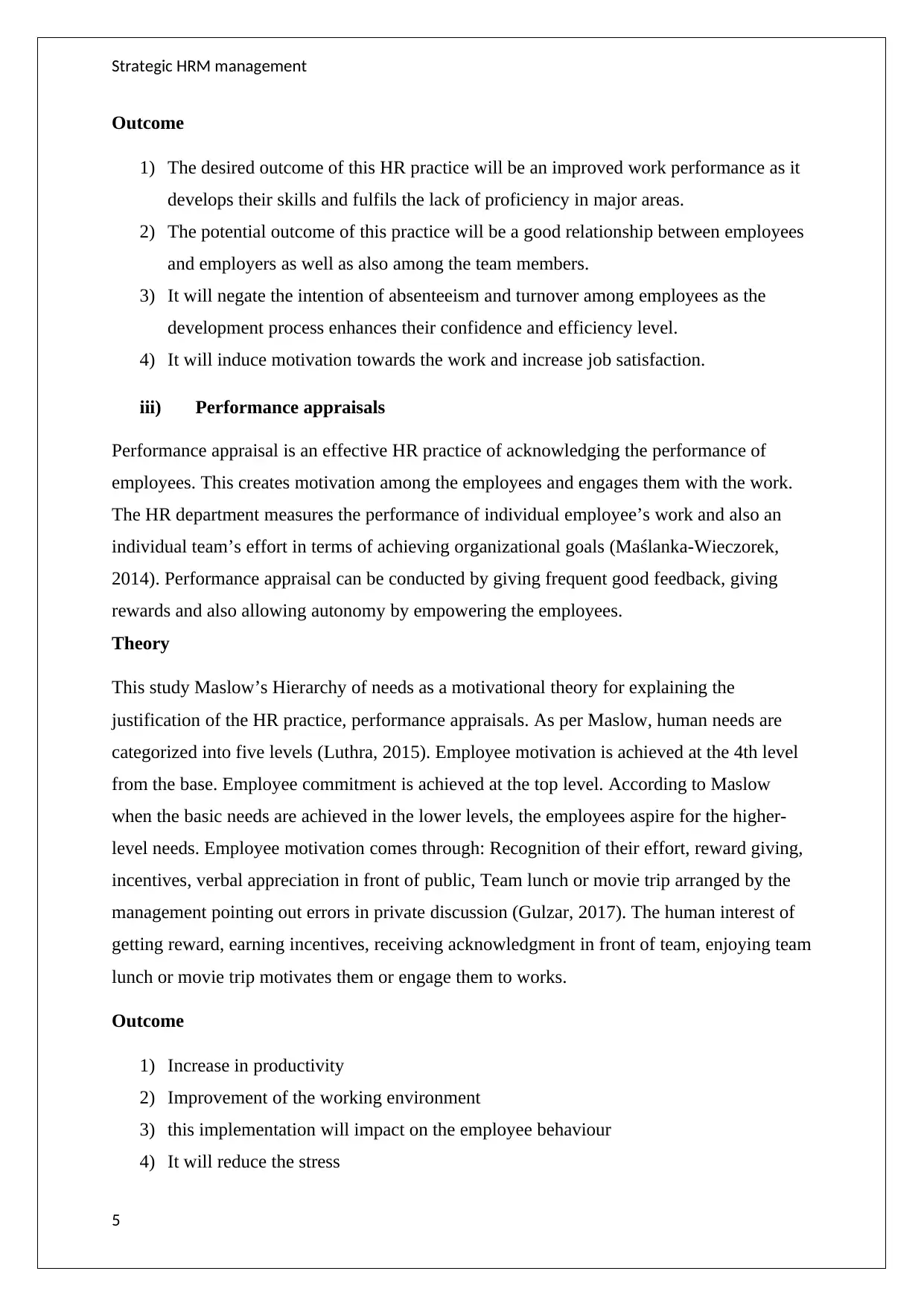
Strategic HRM management
Outcome
1) The desired outcome of this HR practice will be an improved work performance as it
develops their skills and fulfils the lack of proficiency in major areas.
2) The potential outcome of this practice will be a good relationship between employees
and employers as well as also among the team members.
3) It will negate the intention of absenteeism and turnover among employees as the
development process enhances their confidence and efficiency level.
4) It will induce motivation towards the work and increase job satisfaction.
iii) Performance appraisals
Performance appraisal is an effective HR practice of acknowledging the performance of
employees. This creates motivation among the employees and engages them with the work.
The HR department measures the performance of individual employee’s work and also an
individual team’s effort in terms of achieving organizational goals (Maślanka-Wieczorek,
2014). Performance appraisal can be conducted by giving frequent good feedback, giving
rewards and also allowing autonomy by empowering the employees.
Theory
This study Maslow’s Hierarchy of needs as a motivational theory for explaining the
justification of the HR practice, performance appraisals. As per Maslow, human needs are
categorized into five levels (Luthra, 2015). Employee motivation is achieved at the 4th level
from the base. Employee commitment is achieved at the top level. According to Maslow
when the basic needs are achieved in the lower levels, the employees aspire for the higher-
level needs. Employee motivation comes through: Recognition of their effort, reward giving,
incentives, verbal appreciation in front of public, Team lunch or movie trip arranged by the
management pointing out errors in private discussion (Gulzar, 2017). The human interest of
getting reward, earning incentives, receiving acknowledgment in front of team, enjoying team
lunch or movie trip motivates them or engage them to works.
Outcome
1) Increase in productivity
2) Improvement of the working environment
3) this implementation will impact on the employee behaviour
4) It will reduce the stress
5
Outcome
1) The desired outcome of this HR practice will be an improved work performance as it
develops their skills and fulfils the lack of proficiency in major areas.
2) The potential outcome of this practice will be a good relationship between employees
and employers as well as also among the team members.
3) It will negate the intention of absenteeism and turnover among employees as the
development process enhances their confidence and efficiency level.
4) It will induce motivation towards the work and increase job satisfaction.
iii) Performance appraisals
Performance appraisal is an effective HR practice of acknowledging the performance of
employees. This creates motivation among the employees and engages them with the work.
The HR department measures the performance of individual employee’s work and also an
individual team’s effort in terms of achieving organizational goals (Maślanka-Wieczorek,
2014). Performance appraisal can be conducted by giving frequent good feedback, giving
rewards and also allowing autonomy by empowering the employees.
Theory
This study Maslow’s Hierarchy of needs as a motivational theory for explaining the
justification of the HR practice, performance appraisals. As per Maslow, human needs are
categorized into five levels (Luthra, 2015). Employee motivation is achieved at the 4th level
from the base. Employee commitment is achieved at the top level. According to Maslow
when the basic needs are achieved in the lower levels, the employees aspire for the higher-
level needs. Employee motivation comes through: Recognition of their effort, reward giving,
incentives, verbal appreciation in front of public, Team lunch or movie trip arranged by the
management pointing out errors in private discussion (Gulzar, 2017). The human interest of
getting reward, earning incentives, receiving acknowledgment in front of team, enjoying team
lunch or movie trip motivates them or engage them to works.
Outcome
1) Increase in productivity
2) Improvement of the working environment
3) this implementation will impact on the employee behaviour
4) It will reduce the stress
5
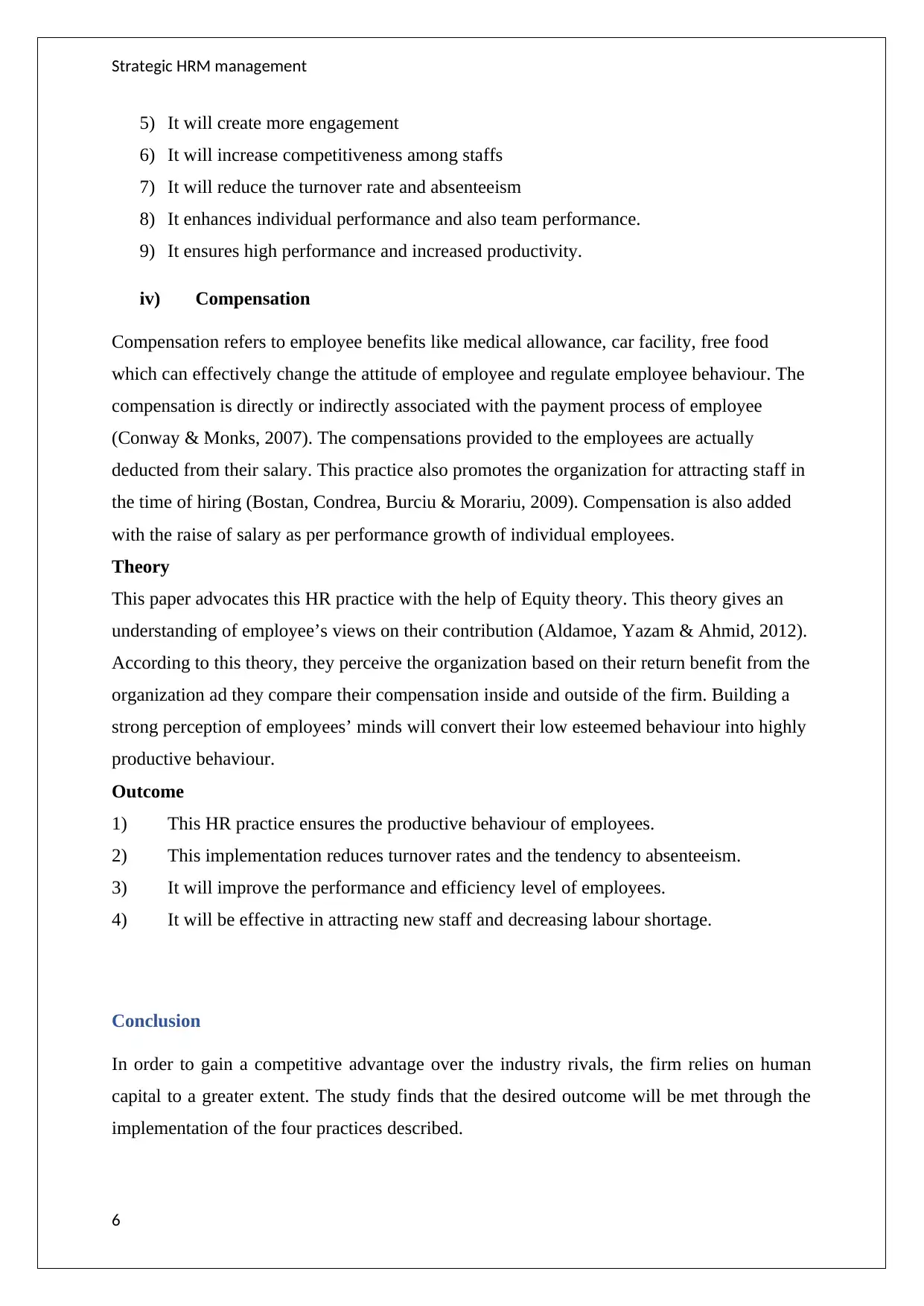
Strategic HRM management
5) It will create more engagement
6) It will increase competitiveness among staffs
7) It will reduce the turnover rate and absenteeism
8) It enhances individual performance and also team performance.
9) It ensures high performance and increased productivity.
iv) Compensation
Compensation refers to employee benefits like medical allowance, car facility, free food
which can effectively change the attitude of employee and regulate employee behaviour. The
compensation is directly or indirectly associated with the payment process of employee
(Conway & Monks, 2007). The compensations provided to the employees are actually
deducted from their salary. This practice also promotes the organization for attracting staff in
the time of hiring (Bostan, Condrea, Burciu & Morariu, 2009). Compensation is also added
with the raise of salary as per performance growth of individual employees.
Theory
This paper advocates this HR practice with the help of Equity theory. This theory gives an
understanding of employee’s views on their contribution (Aldamoe, Yazam & Ahmid, 2012).
According to this theory, they perceive the organization based on their return benefit from the
organization ad they compare their compensation inside and outside of the firm. Building a
strong perception of employees’ minds will convert their low esteemed behaviour into highly
productive behaviour.
Outcome
1) This HR practice ensures the productive behaviour of employees.
2) This implementation reduces turnover rates and the tendency to absenteeism.
3) It will improve the performance and efficiency level of employees.
4) It will be effective in attracting new staff and decreasing labour shortage.
Conclusion
In order to gain a competitive advantage over the industry rivals, the firm relies on human
capital to a greater extent. The study finds that the desired outcome will be met through the
implementation of the four practices described.
6
5) It will create more engagement
6) It will increase competitiveness among staffs
7) It will reduce the turnover rate and absenteeism
8) It enhances individual performance and also team performance.
9) It ensures high performance and increased productivity.
iv) Compensation
Compensation refers to employee benefits like medical allowance, car facility, free food
which can effectively change the attitude of employee and regulate employee behaviour. The
compensation is directly or indirectly associated with the payment process of employee
(Conway & Monks, 2007). The compensations provided to the employees are actually
deducted from their salary. This practice also promotes the organization for attracting staff in
the time of hiring (Bostan, Condrea, Burciu & Morariu, 2009). Compensation is also added
with the raise of salary as per performance growth of individual employees.
Theory
This paper advocates this HR practice with the help of Equity theory. This theory gives an
understanding of employee’s views on their contribution (Aldamoe, Yazam & Ahmid, 2012).
According to this theory, they perceive the organization based on their return benefit from the
organization ad they compare their compensation inside and outside of the firm. Building a
strong perception of employees’ minds will convert their low esteemed behaviour into highly
productive behaviour.
Outcome
1) This HR practice ensures the productive behaviour of employees.
2) This implementation reduces turnover rates and the tendency to absenteeism.
3) It will improve the performance and efficiency level of employees.
4) It will be effective in attracting new staff and decreasing labour shortage.
Conclusion
In order to gain a competitive advantage over the industry rivals, the firm relies on human
capital to a greater extent. The study finds that the desired outcome will be met through the
implementation of the four practices described.
6
Paraphrase This Document
Need a fresh take? Get an instant paraphrase of this document with our AI Paraphraser
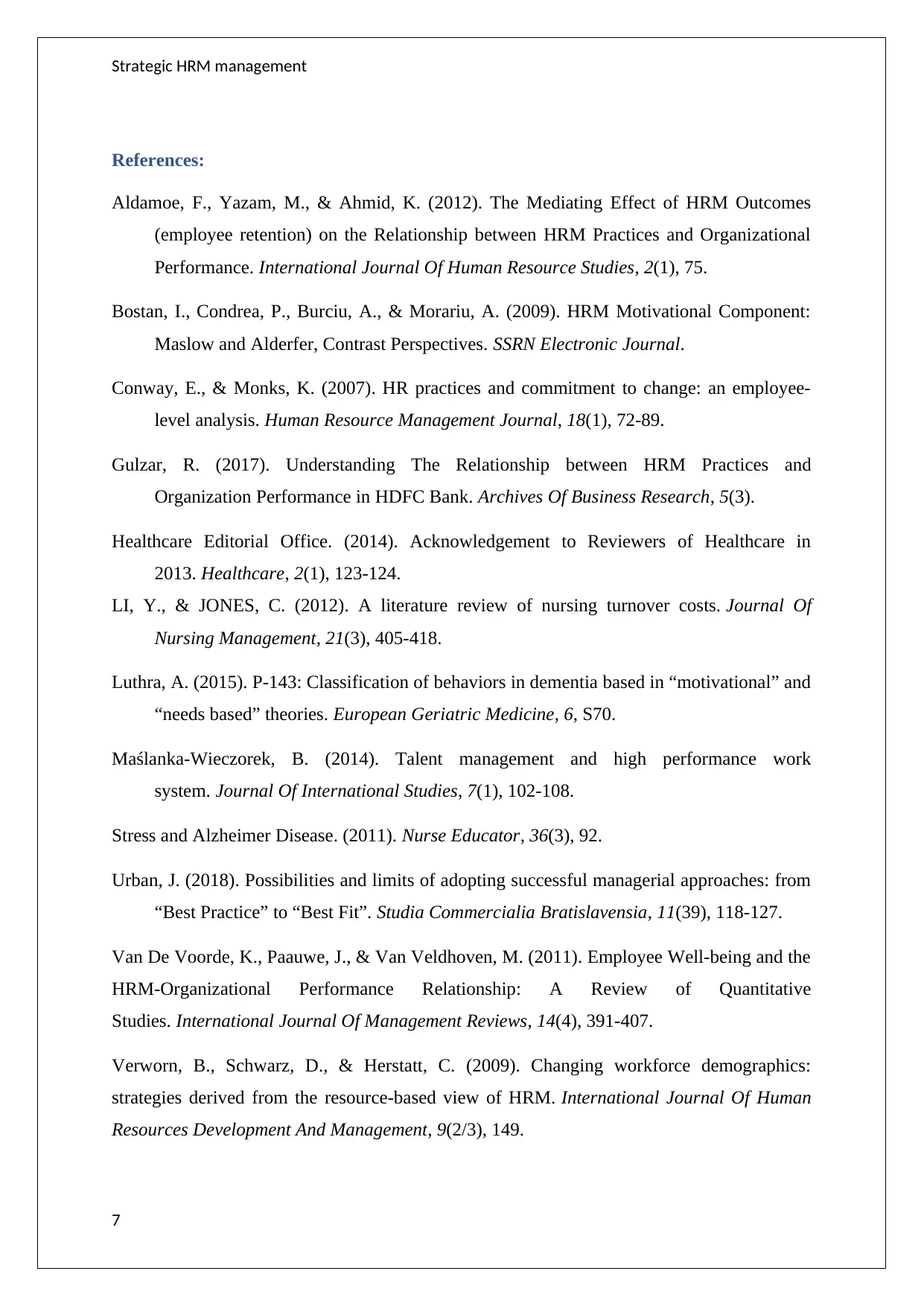
Strategic HRM management
References:
Aldamoe, F., Yazam, M., & Ahmid, K. (2012). The Mediating Effect of HRM Outcomes
(employee retention) on the Relationship between HRM Practices and Organizational
Performance. International Journal Of Human Resource Studies, 2(1), 75.
Bostan, I., Condrea, P., Burciu, A., & Morariu, A. (2009). HRM Motivational Component:
Maslow and Alderfer, Contrast Perspectives. SSRN Electronic Journal.
Conway, E., & Monks, K. (2007). HR practices and commitment to change: an employee-
level analysis. Human Resource Management Journal, 18(1), 72-89.
Gulzar, R. (2017). Understanding The Relationship between HRM Practices and
Organization Performance in HDFC Bank. Archives Of Business Research, 5(3).
Healthcare Editorial Office. (2014). Acknowledgement to Reviewers of Healthcare in
2013. Healthcare, 2(1), 123-124.
LI, Y., & JONES, C. (2012). A literature review of nursing turnover costs. Journal Of
Nursing Management, 21(3), 405-418.
Luthra, A. (2015). P-143: Classification of behaviors in dementia based in “motivational” and
“needs based” theories. European Geriatric Medicine, 6, S70.
Maślanka-Wieczorek, B. (2014). Talent management and high performance work
system. Journal Of International Studies, 7(1), 102-108.
Stress and Alzheimer Disease. (2011). Nurse Educator, 36(3), 92.
Urban, J. (2018). Possibilities and limits of adopting successful managerial approaches: from
“Best Practice” to “Best Fit”. Studia Commercialia Bratislavensia, 11(39), 118-127.
Van De Voorde, K., Paauwe, J., & Van Veldhoven, M. (2011). Employee Well-being and the
HRM-Organizational Performance Relationship: A Review of Quantitative
Studies. International Journal Of Management Reviews, 14(4), 391-407.
Verworn, B., Schwarz, D., & Herstatt, C. (2009). Changing workforce demographics:
strategies derived from the resource-based view of HRM. International Journal Of Human
Resources Development And Management, 9(2/3), 149.
7
References:
Aldamoe, F., Yazam, M., & Ahmid, K. (2012). The Mediating Effect of HRM Outcomes
(employee retention) on the Relationship between HRM Practices and Organizational
Performance. International Journal Of Human Resource Studies, 2(1), 75.
Bostan, I., Condrea, P., Burciu, A., & Morariu, A. (2009). HRM Motivational Component:
Maslow and Alderfer, Contrast Perspectives. SSRN Electronic Journal.
Conway, E., & Monks, K. (2007). HR practices and commitment to change: an employee-
level analysis. Human Resource Management Journal, 18(1), 72-89.
Gulzar, R. (2017). Understanding The Relationship between HRM Practices and
Organization Performance in HDFC Bank. Archives Of Business Research, 5(3).
Healthcare Editorial Office. (2014). Acknowledgement to Reviewers of Healthcare in
2013. Healthcare, 2(1), 123-124.
LI, Y., & JONES, C. (2012). A literature review of nursing turnover costs. Journal Of
Nursing Management, 21(3), 405-418.
Luthra, A. (2015). P-143: Classification of behaviors in dementia based in “motivational” and
“needs based” theories. European Geriatric Medicine, 6, S70.
Maślanka-Wieczorek, B. (2014). Talent management and high performance work
system. Journal Of International Studies, 7(1), 102-108.
Stress and Alzheimer Disease. (2011). Nurse Educator, 36(3), 92.
Urban, J. (2018). Possibilities and limits of adopting successful managerial approaches: from
“Best Practice” to “Best Fit”. Studia Commercialia Bratislavensia, 11(39), 118-127.
Van De Voorde, K., Paauwe, J., & Van Veldhoven, M. (2011). Employee Well-being and the
HRM-Organizational Performance Relationship: A Review of Quantitative
Studies. International Journal Of Management Reviews, 14(4), 391-407.
Verworn, B., Schwarz, D., & Herstatt, C. (2009). Changing workforce demographics:
strategies derived from the resource-based view of HRM. International Journal Of Human
Resources Development And Management, 9(2/3), 149.
7
1 out of 8
Related Documents
Your All-in-One AI-Powered Toolkit for Academic Success.
+13062052269
info@desklib.com
Available 24*7 on WhatsApp / Email
![[object Object]](/_next/static/media/star-bottom.7253800d.svg)
Unlock your academic potential
© 2024 | Zucol Services PVT LTD | All rights reserved.
